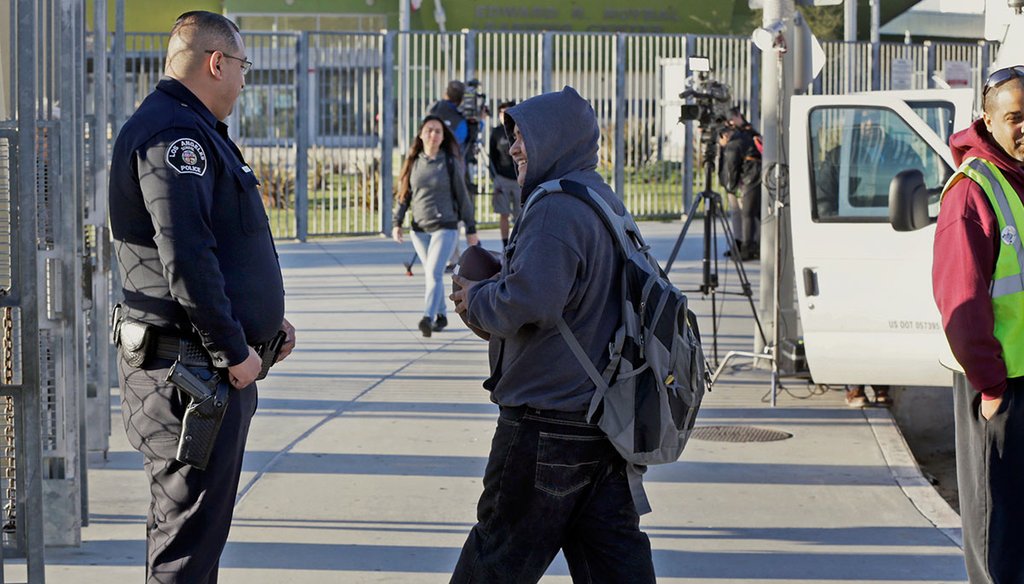



Los Angeles School Police officer Alex Camarillo, left, welcomes area students back to school at the Edward R. Roybal Learning Center in Los Angeles on Dec. 16, 2015. (AP)
Using reliable data sources for salary and public schools, the hypothetical cost of hiring 87,000 IRS tax enforcement agents would be about $6.04 billion, less than the projected $6.96 billion cost of putting police officers at every U.S. public school.
But regardless of the data source used, the claim involves back-of-the-envelope math based on averages.
About half of the nation’s public schools already employ law enforcement or school resource officers, federal data show.
Could money earmarked to hire staff at the Internal Revenue Service be better spent boosting school safety?
A Texas sheriff’s department argued it could.
"With the combined salary of the 87,000 new IRS Agents ($81,456 average annual salary), you could put a police officer ($55,117) in every public school in the nation (97,568) and still have 31,007 police officers or $1,709,012,819 left over. Now you know. They’re not interested in safety or security, they’re after you!" read an Aug. 11 Facebook post from the Clay County Sheriff’s Office.
The post was flagged as part of Facebook’s efforts to combat false news and misinformation on its News Feed. (Read more about our partnership with Facebook.)
Clay County Sheriff Jeff Lyde told PolitiFact the post was based on figures drawn from unofficial aggregate job sites (such as Indeed and Glassdoor). He said he calculated the average from the various sources to arrive at the figures published in the Facebook post.
The most reliable sources of official data suggest this claim is flawed. But either way, the claim involves back-of-the-envelope math based on averages, and doesn’t account for real-world, local-level variables related to salary and existing staffing. It also lacks context about what research reveals about the safety effects of having police officers in schools.
First, let’s look at salaries.
In 2021, the average annual salary for federal revenue tax agents was about $69,400, according to the U.S. Bureau of Labor Statistics, not $81,456.
For law enforcement officers, the 2021 average salary was about $70,750, not $55,117.
The post is off on its public schools numbers, too. Data from the National Center for Education Statistics shows there were 98,469 public schools in the United States in 2020, not 97,568. The latter figure appears to have come from a blog about American public education that uses unsubstantiated data.
Using these figures to apply the math posited in the post, it would cost about $6.96 billion to pay the salaries of one police officer per public school.
The post also assumes that the IRS is hiring 87,000 tax-enforcement agents. That’s misleading.
Congress has approved $80 billion for the IRS to hire as many as 87,000 employees over the next 10 years. That comes as the agency prepares for 50,000 employees to retire over the next five or six years. But there is no indication these new hires would be only tax enforcement personnel; the hires are likely to be spread across the agency — and so not all will be agents.
The Treasury said in 2021 that if the agency were allotted $80 billion, it would hope to spend it on increasing enforcement as well as modernizing antiquated information technology, and investing in meaningful taxpayer service. However, the agency has also stated that it is not yet finalized how it will disburse the funds.
However, if the IRS were hiring 87,000 tax "agents," the cost of those salaries could come in around $6.04 billion. By that math, it would cost about $920 million more to put a police officer in every school than it would to pay for 87,000 IRS agents.
Setting aside cost, research has not found that the presence of resource officers or other law enforcement officials in schools inherently makes them safer from events such as school shootings.
About half of all public K-12 schools in the United States already employ law enforcement or school resource officers, according to the National Center for Education Statistics.
A Facebook post by a Texas sheriff’s department claimed that "with the combined salary of the 87,000 new IRS agents" you could put a police officer in every public school in the U.S. and "still have 31,007 police officers or $1,709,012,819 left over."
The post relies on unofficial data about salaries and schools. Using official data sources and applying the math used in this post, we found that it would cost about $920 million more to put an officer in every school — not $1.7 billion less. But either way, the claim involves back-of-the-envelope math based on averages and doesn’t account for real-world variables.
The post also distorts the number of projected IRS hires who would be tax enforcement agents and arrives at a misleading conclusion.
The statement contains an element of truth but ignores critical facts that would give a different impression. We rate this Mostly False.
Facebook post, Aug. 31, 2022 (archived)
U.S. Bureau of Labor Statistics, Police and Sheriff's Patrol Officers, accessed Sept. 2, 2022
U.S. Bureau of Labor Statistics, Tax Examiners and Collectors, and Revenue Agents, accessed Sept. 2, 2022
PolitiFact, "No, the number of new IRS workers won’t surpass number of police detectives," Aug. 23, 2022
In a world of wild talk and fake news, help us stand up for the facts.
